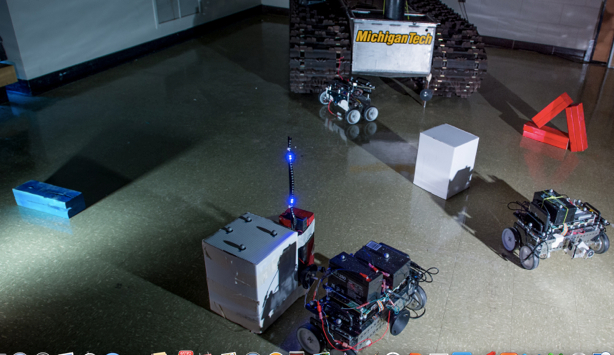Bots on the ground
September 26, 2014

Robot team (credit: Michigan Technological University )
Michigan Technological University engineers have developed a tabletop model of a robot team that can bring power to emergency workers, starting with cell towers to restore communications.
“If we can regain power in communication towers, then we can find the people we need to rescue,” says Nina Mahmoudian, an assistant professor of mechanical engineering–engineering mechanics. “And the human rescuers can communicate with each other.”
The team has programmed robots to restore power in small electrical networks, linking up power cords and batteries to light a little lamp or set a flag to waving with a small electrical motor.
The robots operate independently, choosing the shortest path and avoiding obstacles, just as you would want them to if they were hooking up an emergency power source to a cell tower.
“Our robots can carry batteries, or possibly a photovoltaic system or a generator,” Mahmoudian said. The robots could also recharge one another.
The devices could also have military uses, particularly for special forces on covert missions. “We could set up power systems before the soldiers arrive on site, so they wouldn’t have to carry all this heavy stuff,” said Mahmoudian.
NASLabMichiganTech | Autonomous Power Distribution System: Multiple Agents
The team’s next project is a full-size, working model of their robot network. Their first robot is a tank-like vehicle to develop path-planning algorithms.
During search missions like the one conducted for Malaysia Airlines Flight 370, the underwater vehicles scanning for wreckage must come to the surface for refueling. Mahmoudian envisions a fleet of fuel mules that could dive underwater, charge up the searching robot and return to the mother ship. That way, these expensive search vehicles could spend more time looking for evidence and less time traveling back and forth from the surface.
The team presented a paper describing their work, “Autonomous Power Distribution System,” at the 19th World Congress of the International Federation of Automatic Control, held Aug. 24-29 in Cape Town, South Africa.
Funding has been provided by Michigan Tech’s Center for Agile Interconnected Microgrids.
Abstract of Autonomous Power Distribution System
This paper describes path planning and control of an autonomous power distribution system. The aim is to study the use of the autonomous mobile power-grid systems after disasters to accelerate search, rescue, and recovery efforts. The concept is demonstrated through an autonomous electrical cabling and connection mission between a power source and a power load in a cluttered environment using lab-size platforms. The developed system will be scalable to real-size. The ultimate goal of this work is developing intelligent power electronics and a distributed autonomous mobile microgrid. It will be capable of regulating power flow at a desired voltage and frequency level, meeting load demands and adaptable to changes in situation, power demands, or generations.